Laptop Mag Verdict
This monstrous 18.4-inch gaming rig delivers fantastic frame rates, Blu-ray playback in full HD, and a blazing SSD.
Pros
- +
Blazing fast performance
- +
Fast SSD hard drive
- +
Gorgeous HD screen
- +
Great webcam quality
Cons
- -
Heavy
- -
Warm temperatures above deck
Why you can trust Laptop Mag
Greenness
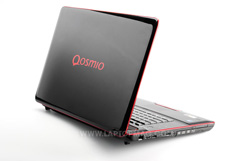
Click to enlargeWhen charging, It took 1 hour and 29 minutes to reach 80 percent of capacity, and a full 2:31 to get to full charge, about 22 minutes longer than the category average. During that time, the X505 used an average of 68.4 watts, a couple of watts more than average (65.4). However, because of its above-average battery life, the notebook gets a LAPTOP Green Efficiency Rating of 60.4, which is 7 points better than the category average 67.3 (lower is better).
Software and Warranty
Toshiba bundles a number of useful utilities with the Qosmio X505. You get Toshiba's attractive Bulletin Board software, which makes it easy to organize photos, calendars, notes and more in one place. ReelTime provides an attractive interface for finding recently opened files. Toshiba Recovery Media Creator lets you burn system rescue discs; Toshiba ConfigFree manages network connections; Toshiba Disc Creator is a standard CD/DVD burning program; and Toshiba DVD Player allows you to view standard DVD movies. There's also a Toshiba facial recognition program.
Toshiba's power-saving Eco Utility and PC Health Monitor are the most interesting of its bundled utilities. The Eco Utility allows you to see, in real-time, how much power the system is using, and to adjust power settings accordingly. The PC Health Monitor shows the temperature of the CPU, the fan speed, battery status, power consumption, and health of both storage drives. We wish, however, that we were able to control the fan speed manually.
In addition to these tools, the X505 comes bundled with a few third party applications, including Corel DVD MovieFactory for burning DVDs and InterVideo WinDVD for playing Blu-ray discs.
The X505 comes with a standard one-year warranty on parts and labor. Toll-free phone support is available 24/7. To see how Toshiba fared in our Tech Support Showdown, click here.
Verdict
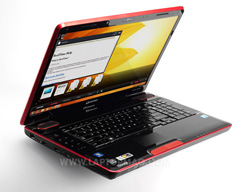
Click to enlargeWith the Qosmio X505-Q890, Toshiba has really upped the ante on what was already an industry leading gaming notebook. That said, competitors have also stepped up their game in this price and size range. If you're looking for something a little more portable (relatively speaking), the 17-inch ASUS G73JH ($1,599; $1,699 with Blu-ray) pairs dual 7,200-rpm drives with a slightly slower 1.6-GHz Intel Core i7-720QM CPU, but a slightly faster ATI Mobility Radeon HD 5870 graphics card. However, if you're looking for a gorgeous multimedia experience with a giant 18.4-inch screen, great speakers, and unmatched CPU performance, look no further than the Qosmio X505-Q890.
Graphics & Gaming
With its discrete Nvidia GeForce GTS 360M graphics, the Toshiba Qosmio X505 is a force to be reckoned with. On 3DMark06, a benchmark that measures overall graphics prowess, the X505 scored an amazing 9,801, which is comfortably faster than the category average of 7,271 and a bit faster than the original X505's score of 8,313.
There's no doubt the X505 is more than capable of playing demanding 3D games. In World of Warcraft, the notebook managed a blinding 326 frames per second at 1024 x 768 resolution and an amazing 78 fps at its native 1920 x 1080 resolution. Both numbers blow away the category averages of 132 and 46 fps. The ASUS G73Jh, with its ATI Mobility Radeon HD 5870 graphics, achieved a comparable 318 fps at 1024 x 768 but a stronger 111 fps at 1920 x 1080.
On the more-demanding Far Cry 2, the X505 got a blistering 100 fps at 1024 x 768 and 33 fps at 1920 x 1080. Those numbers beat the tar out of the category average of 68 and 29 fps, but aren't as strong as those provided by the ASUS G73Jh (110 and 51 fps).
When we played Call of Duty: Modern Warfare 2, another graphically intensive first-person shooter, the X505 provided a great 66 fps at 1024 x 768, which dropped to a still-strong 45 fps at 1920 x 1080. During both full HD and 1024 x 768 play, images were sharp and motion extremely smooth. At the higher settings, we were impressed by the level of detail on 3D objects (leaves on trees, for example) and even more impressed that those details didn't slow down our play at all.
Battery Life and Wi-Fi
You can't expect long battery life from an 18.4-inch, 10.6-pound notebook, but we were surprised by how much endurance we actually got. On the LAPTOP Battery Test, which involves continuous surfing over Wi-Fi, the X505 lasted 2 hours and 51 minutes, which is 24 minutes longer than the category average of 2:27 and nearly an hour longer than the ASUS G73Jh. Of course, you're probably going to do more than web surf on this notebook.
The X505's Realtek RTL8191 802.11n radio managed strong transfer rates of 40.2 and 25.5 Mbps at distances of 15 and 50 feet from the router, respectively. Those numbers compare favorably to the ASUS G73Jh (37.1/19.6 Mbps).
Configuration Options
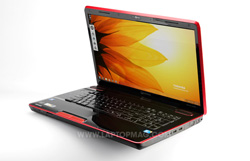
Click to enlargeOur $1,899 review unit features the quad-core Core i7-740QM processor, a full 1920 x 1080 screen, 6GB of RAM, a Blu-ray reader, and a 64GB SSD in addition to the 500GB hard drive. However, the Qosmio X500 series starts at $1,199. For that price, you get a dual-core 2.26-GHz Core i5-430M CPU, the same GeForce GTS 360M graphics as on our review unit, 4GB of RAM, a single 500GB hard drive, a DVD burner, and a lower-resolution 1680 x 945 screen.
Amongst the 13 different configurations ranging in price from $1,199 to $1,899, some have the dual-core 2.26-GHz Core i5-430M CPU while others feature the quad-core 1.73-GHz Core i7-740QM. The lower priced configurations have only a 1680 x 945 screen, but those with prices of $1,649 and above have full HD 1920 x 1080 panels. RAM ranges from 4GB to 6GB, hard drives come in either 320GB or 500GB capacities, and only the most expensive configs also include the 64GB SSD. Some models have Blu-ray drives and others have DVD burners.
Our configuration, the X505-Q890, has all the highest specs, but if you want to save a few dollars, we recommend the X505-Q888. That model lacks an SSD and has 4GB instead of 6GB of RAM, but is otherwise identical to the X505-Q890. Whatever you do, don't buy a model with the 1680 x 945 screen, as the full HD panel is the best feature of the entire Qosmio X500 series.
Display and Sound
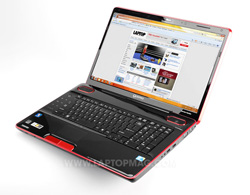
Click to enlargeThough it's designed for gaming, the Qosmio X505-Q890 makes an excellent multimedia system. The gorgeous 18.4-inch, 1920 x 1080-pixel screen is the real star of the show, offering plenty of screen real estate with beautiful, sharp images. When watching videos, such as a Blu-ray of Iron Man, the high-definition video was sharp, smooth, and colorful. Of course, when we watched a streaming 720p video of Fringe we noticed some blockiness because the screen was at a higher resolution than the video.
The Harmon Kardon speakers are good enough to turn the X505-Q890 into a stereo substitute. When streaming "Stuck on Repeat" by Little Boots, the sound was accurate if not overly rich and loud enough to fill a large living room.
Ports and Webcam
For such a large system, the Qosmio X505-Q890 has a pretty standard array of ports. On its right side are two USB ports, audio in/out, and VGA out. Its left side is adorned with Ethernet, HDMI, a Firewire 400 port, ExpressCard/54 reader, and a USB/eSATA port for a total of three USB ports overall. The front lip houses a 5-in-1 memory card reader and a Wi-Fi on/off switch. The only port we wish the X505-Q890 had is USB 3.0.

Click to enlarge

Click to enlarge
The X505-Q890's 1.3-megapixel webcam produced impressively sharp and bright images even in our dimly lit cubical. When talking on Skype, our image was colorful and the video smooth.
Performance
Just from its specs, we could predict that the Qosmio X505-Q890 would provide epic performance. The notebook's 1.73-GHz Intel Core i7 Q740 CPU has four high-speed cores that can run a whopping eight threads at once, improving your multitasking or boosting the performance of multithreaded apps. Its Nvidia GeForce GTS 360M discrete graphics card is loaded with 1GB of graphics memory, and it has two storage drives: a speedy 64GB SSD boot drive and a 7,200-rpm, 500GB hard drive.
On PCMark Vantage, a synthetic benchmark that measures overall system prowess, the Qosmio X505 scored a whopping 10,392, which is nearly double the category average for desktop replacements (5,308) and 80 percent better than the ASUS G73Jh (6,460). In fact, that's the third highest score we've ever seen, behind only the more expensive and boutique-oriented $3,966 Malibal Satori (13,187) and the $5,952 Origin EON18 (11,039), both of which use desktop components.
The 64GB SSD booted Windows 7 Home Premium (64-bit) in a speedy 52 seconds, 11 seconds faster than the category average and 15 seconds faster than the ASUS G73Jh, but about 4 seconds slower than the original X505.
We conducted our LAPTOP File Transfer Test, in which we copy 4.97GB of files on the 7,200-rpm hard drive, and saw it complete in a mere 2 minutes and 51 seconds for a rate of 37.1 MBps, comfortably faster than the 32.6 MBps category average and the 31.2 MBps turned in by the ASUS G73Jh. When it came to transcoding video, the X505-Q890 also converted a 114MB MPEG-4 in just 57 seconds, 6 seconds faster than the category average of 1:03.
When we first reviewed the Toshiba Qosmio X505 in October 2009, we were impressed by its gorgeous 18.4-inch full HD screen, speedy solid state drive, and blazing Core i7 quad-core performance. Now, Toshiba's updated one of our favorite gaming systems with an even faster processor and graphics card, making it the most powerful sub-$2,000 gaming system we've ever tested. This machine is the ultimate desktop replacement.
Design
The Qosmio X505-Q890 has an identical chassis to the original Qosmio X505, which is a good thing. Its glossy black plastic chassis has tasteful accents that make this notebook look much more adult and classy than the average gaming notebook while maintaining the festive aesthetic players prefer. On the back of the lid, which features an interlocking grid pattern, is an attractive red Qosmio logo. The lid, base, and speakers are outlined in metallic red trim, while the two touchpad buttons have the same metallic red color.
At 17.4 x 11.6 x 1.6 inches and 10.6 pounds (0.2 pounds heavier than the original), the X505-Q890 is not a system you'll carry around much. However, it's lighter than the average gaming desktop and compact enough to lug with you to a LAN party, provided you can find a laptop bag that accommodates its huge dimensions. The 2-pound power brick, which you could practically use for doing bicep curls, adds to your load. Find something with rollers.
Keyboard and Touchpad
The huge 104-key keyboard on the X505-Q890 has a numeric keypad and lights up to help gamers play in dimly lit rooms. Though there's plenty of area to stretch out your fingers, the keyboard's glossy surface can feel a bit slippery, and the narrow space between the keys may pose an accuracy challenge to those with long nails. That said, we were able to achieve a very strong score of 86 words per minute on the Ten Thumbs typing test with a low 1-percent error rate. That's better than our average 80-word-per-minute score.
The 3.2 x 1.6-inch touchpad seems tiny in proportion to the two giant mouse buttons, but it allowed us to navigate around the desktop with great accuracy, and it supports multitouch gestures such as pinch-to-zoom. The mouse buttons provided just the right amount of tactile feedback, too.
All of that said, we're glad there's a button right above the touchpad that allows you to quickly disable it, and that a red light above the pad shows you when its enabled, because the pad seems a little too small for navigating high-speed frag fests. We imagine most users will opt to plug in a mouse when gaming.
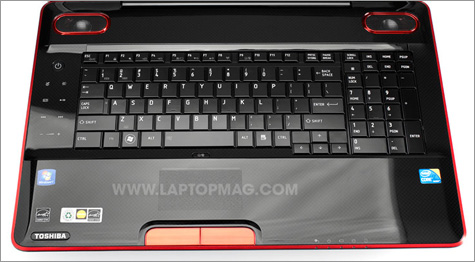
Click to enlarge
Heat
When performing everyday tasks such as surfing the web, the Qosmio X505-Q890 stays extremely cool at all the major touch points. After streaming a full-screen web video for 15 minutes, the touchpad measured just 83 degrees, the keyboard 86 degrees, and the bottom only 91 degrees Fahrenheit. Those numbers are extremely low; we consider anything under 95 degrees comfortable and below 90 degrees extraordinary.
Unfortunately, the X505-Q890 gets quite a bit hotter under more strenuous conditions. After playing City of Heroes for 45 minutes, we measured the touchpad at 95 degrees, and the space between the G and H keys on the keyboard reached a whopping 104 degrees. However, the keys themselves actually didn't feel very warm to the touch. The area above the keyboard, however, reached a very high 124 degrees Fahrenheit. You wouldn't touch this area during normal use, but we could still feel heat radiating from it. Whatever you do, keep exposed skin away from the power brick, which we measured at 140 degrees! All these temperatures were taken in an air conditioned room.
Toshiba Qosmio X505-Q890 Specs
| Bluetooth | Bluetooth 2.1+EDR |
| Brand | Toshiba |
| CPU | 1.73-GHz Intel Core i7-740QM |
| Card Slots | 5-1 card reader |
| Company Website | http://www.toshiba.com |
| Display Size | 18.4 |
| Graphics Card | Nvidia GeForce GTS 360M |
| Hard Drive Size | 64GB SSD and 500GB |
| Hard Drive Speed | 7,200rpm |
| Hard Drive Type | Multiple Drives |
| Native Resolution | 1920x1080 |
| Operating System | MS Windows 7 Home Premium (64-bit) |
| Optical Drive | BD-ROM/DVDRW DL |
| Optical Drive Speed | 6X |
| Ports (excluding USB) | Firewire 400, ExpressCard/54, S/PDIF, Ethernet, Microphone, eSATA/USB, Kensington Lock, Headphone, HDMI |
| RAM | 6GB |
| RAM Upgradable to | 8GB |
| Size | 17.4 x 11.6 x 1.6 inches |
| Touchpad Size | 3.2 x 1.6 |
| USB Ports | 3 |
| Video Memory | 1GB |
| Weight | 10.6 pounds |
| Wi-Fi | 802.11b/g/n |
| Wi-Fi Model | Realtek RTL8191SE |

